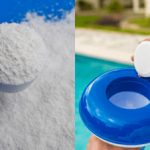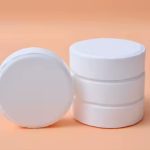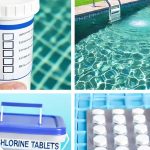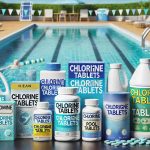In the process of pool water treatment, chlorine and shock are two common methods. Chlorine is a commonly used disinfectant, used to kill bacteria and viruses in the water, ensuring the hygiene of the pool water. Shock is a method used to eliminate organic impurities and contaminants in the pool, keeping the water clear and transparent. However, many people are unsure whether chlorine and shock can be used simultaneously or if there are potential conflicts between them. In this article, we will explore the roles of chlorine and shock in pool use and the question of whether they can be used simultaneously.
It is indeed necessary to use chlorine tablets and shock simultaneously. Without chlorine tablets, chlorine shock dissipates quickly from the water; without shock, chlorine levels will not rise enough to fully disinfect the water.

Chlorine’s Role
Chlorine is a common pool disinfectant, primarily used to kill bacteria, viruses, and other harmful microorganisms in the water to ensure the cleanliness, health, and safety of the pool. Normally, the pool water needs to maintain an appropriate chlorine concentration to prevent bacterial growth, keeping the pool clean, healthy, and safe.
Chlorine tablets are typically placed in solid form in a chlorinator, floater, or skimmer basket, slowly releasing chlorine into the pool water. Their role is to maintain residual chlorine in the water to ensure continuous disinfection. Chlorine tablets help maintain the stability of pool water quality, ensuring that the water remains at the appropriate chlorine concentration.
Shock’s Role
Shock is a high concentration of chlorine, usually added to the pool in granular or powder form. Its main purpose is to rapidly increase the chlorine levels in the pool water to address specific situations, such as severe contamination, heavy pool usage, or a decrease in chlorine levels. Shock can quickly kill bacteria and eliminate organic pollutants, restoring water clarity and transparency.
Differences Between the Two
Chlorine and shock both contain similar active chemicals for pool disinfection. However, the main difference lies in their chemical strength. Shock has a higher chlorine concentration, allowing it to rapidly increase chlorine levels in the pool water to address contamination or special situations.
Traditional chlorine products (such as chlorine granules, liquid chlorine, and chlorine tablets) are used to maintain chlorine levels, with lower concentrations that cannot quickly eliminate organic waste, bacteria, and algae like shock.
The use of chlorine is typically continuous, maintaining chlorine levels in the pool water by adding the appropriate amount of chlorine products. This helps maintain the pool’s water quality but cannot address sudden water quality issues.
In contrast, shock should be applied as needed, usually in larger doses when water quality problems arise. This can quickly kill bacteria and eliminate contaminants but is not suitable for daily water quality maintenance.
Shock Treatment Approach
If your pool has visible algae problems, such as black algae, mustard algae, or green algae, it is usually necessary to increase the dosage of pool shock treatment, possibly double or triple the normal dosage, to eliminate the algae problem. This is the power of pool shock, which can quickly kill algae and clear water quality issues.
Dosage Control: For example, a pound of pool shock treatment can provide seven parts per million of free chlorine, effectively eliminating algae and other pollutants.
However, be sure to determine the appropriate shock dosage based on the pool’s capacity and the severity of water quality issues. Use shock products specifically designed for pools and follow the guidance on the product label to ensure proper use.
Regular Shock Treatment: We recommend shocking the pool every week to two weeks to maintain the cleanliness and health of the water. However, in hot weather or frequent pool usage, you may need to shock the pool more frequently to address higher water quality challenges.
In conclusion, chlorine and shock are both essential methods for maintaining pool water quality, but their use requires caution. Proper chlorine concentration and shock treatment can ensure clear and transparent pool water while killing harmful microorganisms and removing organic impurities. If there are any concerns or uncertainties, it is advisable to consult and contact us to ensure that your pool water quality remains in optimal condition.




